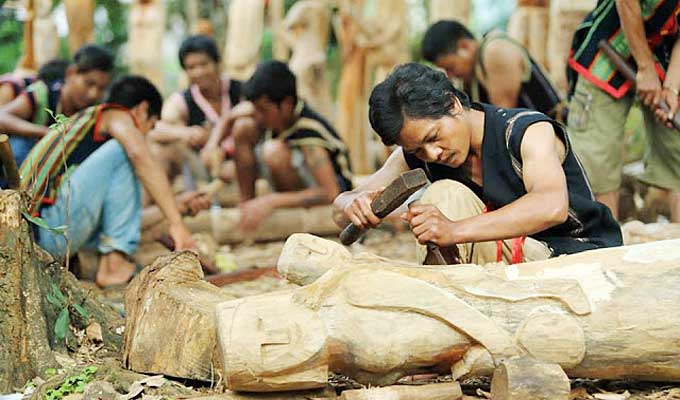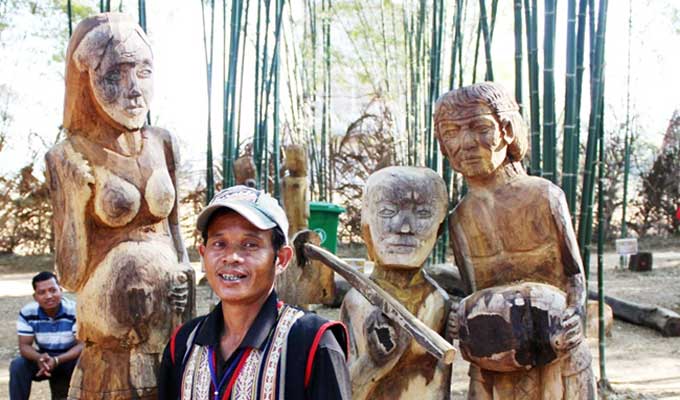Being well-known as a grave statue–carving artisan and wooden statue-maker, artisan A Doan in Dac Ha Commune, Tu Mo Rong District in the Central Highlands Province of Kon Tum, has greatly contributed to preserving this unique art, promoting the culture of the Central Highlands.

Keeping values
Artisan A Doan worries about the future of many aspects of the culture of ethnic minority groups including Bana, Giarai, Ede and Mnong. He said, “I’m always afraid of the disappearance of the cultural beauties of the Central Highlands people”.
For many years, A Doan has devoted his life to grave statue–carving arts—the core of the folk wooden carving in the region. Despite travelling to many places and many ups and downs in his life, A Doan has kept intact his passion for this trade. He shared, “Wooden carving has been familiar to me since I was born.”
Several generations of A Doan’s family have been fascinated with statue carving and their working skills have been preserved and taught methodically. They not only carved what they liked but also travelled all villages, forests and moutains to “capture” the beauties of the Central Highlands for their imaginations. In the view of A Doan, the passionate eyes of epic singers, the carriage of bareback men while playing the gongs, and the appearance of women as clearing trees for cultivation and comforting children are the upright and kind-hearted beauties that need to be depicted.
Artisan A Doan has finished a set of wooden statues reproducing the activities of a family. A Diu, a relative of A Doan, explained that the statues featured the image of a couple coming back home after working in the field. The woman held an axe, carried a basket of vegetables, wild leaves and food on her back; meanwhile, the man carried a slingshot to chase wild animals, and the children were burning wood for cooking.
However, he shared that previously, it took only one day of wandering in the forest for him to find hundreds of beauties to depict, but now he had to wander for two days to find inspiration for his work. A Dau, one of A Doan’s neighbours, said, “A Doan is very good. He has performed statue carving everywhere, aiming to make all people understand more about the deepest meaning of this trade. He taught me and many others in order to preserve the village’s soul.”

Conveying messages
There are many reasons for A Doan’s and A Dau’s worries. Looking at the quiet houses under the trees in the dark, A Doan feels sad. He shared, “Each carved statue wants to convey a message, for both present and future. In many villages, young people drink wine in the night, while sometimes men hit the women, so the warmness in the families as in the past is gradually deteriorating. During the festivals, I have visited all the homes to explain the meaning of the statues and communicate the past beauty of the village.
According to elders of the village, the carving of statues at the tombs is derived from two myths of the natives. A legend tells that in the old days, when a rich and powerful chieftain of the ethnic minority groups in the Central Highlands region died, one of the villagers was also buried as a valet. However, later, they carved wooden statues to be buried instead of living people. Another legend tells that there was a beautiful girl who was well-known and admired by many boys thanks to her diligence, as well as her beautiful singing voice and skilful dance. However, unfortunately she suddenly died, and a boy who loved her very much was crying beside her grave; then he also died and transformed into a wooden statue to protect and talk to her.
The legends aim to highlight the sincere remembrance and tribute of the living to the dead. They believed that the carved statues would relieve their deceased relatives and help protect their graves.
The grave statues in the Central Highlands region are made of natural materials such as roots, bark and the leaves of trees in the forest as well as charcoal and the blood of animals for hecatomb. The carvers must grasp all the shades and the purity of the deads in order to create soul statues.
In addition to carving grave statues, nowadays artisans in the region, like A Doan, carve statues of the living and many other things such as birds and wild animals for interior and outdoor decoration. The statues have different shapes, but they all convey specific messages. Pointing at the statue titled “A Hard-Working Woman,” A Doan explained that the most holy and respectable beauty of Central Highlands women is that they are hard-working. Nowadays, many young people prefer pleasure to work and even ape bad hehaviours; therfore, this statue seems to remind them to preserve their simple beauty.
A man named A Linh in Dac Sao Commune was an example of prefering pleasure to work, annoying and drinking alcohol two years ago. After that, A Doan taught him to carve wooden statues, talked about the meaning of statues and responsible men, and helped him gradually recognise the beauty, humanity and values of labour, as well as have good behaviour within the community.
In the flow of life
The wooden statue-carving artisans have contributed unique arts works to the contemporary life. Several artisans have ‘entered the flow of life’ in order to spread the trade’s essence into the community.
A Doan said, “I was invited to join the jury for many statue carving contests at district, province and region levels. Witnessing people’s attention to and fascination with the works of art, I believed that there would be more and more people knowing the Central Highland people’s characteristic beauties.”
Many artisans are making efforts to preserve and promote the local culture in order that not only the domestic community but also international visitors might admire the beauty of wooden statues from the Central Highlands region. The statues are not only works of art, but also have spiritual meaning, featuring close and familiar features such as the anxiousness of the elders, the souls of women and the tasks of production.
The beauty of wooden statue in the Central Highlands region is the image of people in the daily life.